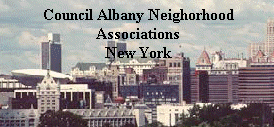Council of Albany Neighborhood Associations
Statement of Vision For Albany
CANA's Statement of Goals: The underlying principle in our stated goals is this:
"What is good for the residents of Albany's neighborhoods, is good for the
vitality, well being and growth of the entire community."
The standard of life in any community is only as good as the quality of living
in all its neighborhoods. Our principle resource- people- should be afforded the
proper environment and the opportunities to grow and improve their quality of
life.
On January 5, 2005, the Council of Albany Neighborhood Associations adopted a
statement of vision for the City of Albany with the following goals:
I. Albany must be supported in its development as an urban center with a focus
on maintaining the highest possible quality of life:
" Walking, cycling and other forms of transportation that are clean and
healthful alternatives to the automobile must be encouraged and promoted,
through the development of safe, affordable and attractive facilities;
" All neighborhoods should be developed to include a range of housing
opportunities and essential and complimentary business enterprises to promote
their safety, diversity and vitality. Residents must feel safe in their homes
and on the streets;
" Downtown development must include residential opportunities, as well;
" Infill development opportunities must be promoted/pursued to maximize
taxable value, eliminate blight, and encourage vital neighborhoods of
appropriate density to support necessary neighborhood services;
" Housing, educational, and cultural opportunities must be offered within
Albany that are fully competitive with those offered in other communities, so
that the City is considered a desirable place to live;
" The urban character and vitality of Albany must be publicly promoted and
celebrated:
" Neighborhoods are the core strength of the City, and neighborhood
associations are vital to the health and well-being of each neighborhood.
Neighborhood associations must be recognized as partners in future development
within their jurisdictions, both for guidance, vision, and support;
II. Albany must be treated as a capital city:
" Development proposals for locations in the City must be designed to
reflect the significance of a location in the capital of the State of New York;
" The publicly-owned facilities of the City must be maintained and improved
to reflect the grandeur incumbent upon a capital city;
" The historic significance and importance of Albany as the capital of the
Empire State must be publicly promoted and celebrated.
III. Albany must celebrate the diversity within:
" The diverse backgrounds and heritage of Albany's people need to be
recognized as a source of strength. All members of the Albany family are to be
respected and nurtured to their fullest potential, and provided the fullest
opportunity to participate in the civic realm through unfettered access to and
understanding of, the governmental decision-making process. Albany must protect
and defend democracy. All citizens should have the opportunity to be heard and
to participate in City government and in their neighborhoods;
" The full resources of Albany's educational, cultural and financial
institutions must be brought to bear to ensure full and equal opportunity for
all residents of the community;
" The diversity of Albany must be publicly promoted and celebrated,
including the diversity of its people, its architecture, and its institutions;
IV. Albany must become a City of the future while respecting its significant
past:
" Albany must pay attention to the needs and wants of the current and the
next generation to ensure that it remains an attractive and viable place to
live, including offering relevant career opportunities, quality health care,
enjoyable and healthful recreational opportunities, and quality educational
services;
" The significant natural beauty of the region - such as the Hudson River,
the Pine Bush and the Helderbergs - must be preserved at the same time as it is
utilized to attract new residents;
" New methods of underwriting the cost of municipal finance must be
explored to avoid overburdening homeowners with the operation of City
government. Fiscal restraint is essential to avoid economic dislocation of the
poorer residents of the community who contribute to its diverse richness.
